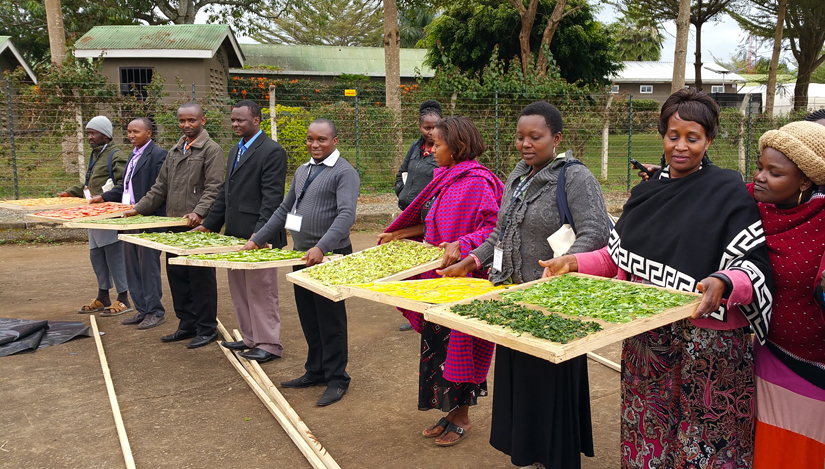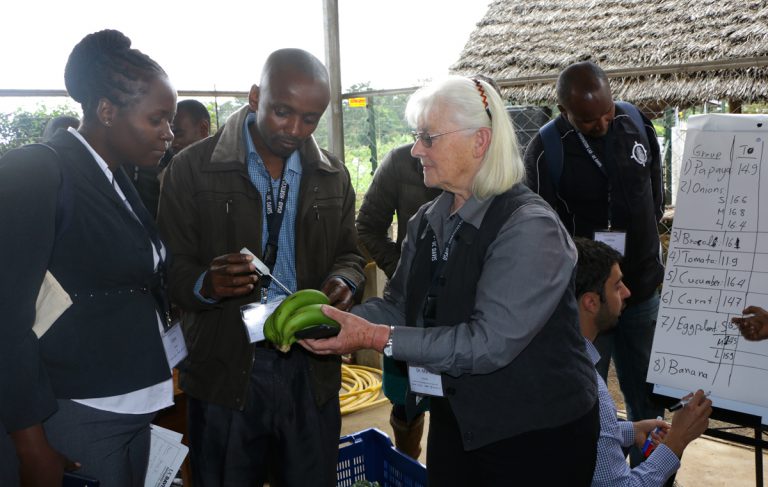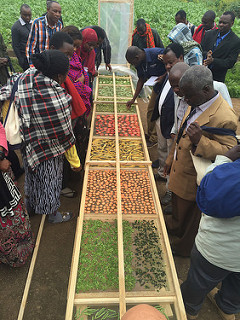

Editor’s note: Michael Reid shares highlights from a five-day short course on postharvest handling of horticultural crops, funded and led by the Horticulture Innovation Lab in Tanzania this summer.
In July, Angelos Deltsidis and I travelled to Tanzania along with Marita Cantwell, our colleague from the UC Davis Postharvest Technology Center, to provide a training in postharvest handling of horticultural crops. The five-day short course was conducted at the Postharvest Training and Services Centeron the World Vegetable Center (AVRDC) campus in Arusha. Ngoni Nenguwo, the AVRDC postharvest technologist, and Juma Shekidele from the Horticultural Research and Training Institute in Tengeru (called HORTI Tengeru) provided invaluable assistance in organizing and hosting the course. Ngoni also taught some of the course modules during the five-day course.
The 40-plus attendees came from all over Tanzania, including university teachers, technical trainers, industry leaders, and representatives of relevant government departments. They were welcomed by Jackie Mkindi of the Tanzania Horticultural Association (TAHA), and Bertha Mjawa with the Tanzania government’s Market Infrastructure, Value Addition and Rural Finance (MIVARF), who also taught a course module.

Each day the course started with lectures covering postharvest principles and practices for crops either grown locally in Tanzania or with potential to grow in Tanzania, including eggplants, tomatoes, bananas, mango, papaya, citrus, avocado, leafy greens, green beans, cherimoya, onions, cut flowers, cucumber, potatoes and carrots.
In addition to the lectures, we included a strong hands-on element in the course. Participants conducted exercises examining maturity, produce quality, cooling, packaging, and water loss. Each participant also received a toolkit of postharvest-related tools, and through the exercises they learned how to use the tools with different fruits and vegetables.
The postharvest workshop activities included constructing a chimney solar dryer and preparing tomatoes, mangoes, carrots, amaranth, green beans, and other horticultural crops to dry. Horticulture Innovation Lab photo by Angelos Deltsidis/UC Davis.

The course also included a module on solar drying, in which attendees constructed and tested the UC Davis-designed chimney solar dryer. For the purposes of the exercise, we constructed the bed of the dryer from plastic crates covered with black plastic, and the chimney comprised four poles pounded into the ground. The dryer proved its effectiveness; despite heavily overcast conditions, products dried rapidly.
The class also took a couple of short field trips, visiting the local wholesale market and an export packing operation handling green beans. The group also visited HORTI Tengeru, where there is a horticulture demonstration area and ongoing horticultural field trials. A charcoal evaporative cooler is being constructed on the site, in partnership with AVRDC. The Horticulture Innovation Lab team had earlier fitted another cool room at HORTI Tengeru with a CoolBot-controlled air conditioner for cool storage of fresh produce.
Since returning to California, we have heard that participants have already shared what they learned about the chimney solar dryer in other parts of Tanzania. The dryer has been featured in demonstrations for farmer field days—specifically with the SEVIA project in Moshi and with the Agricultural Research Institute-Uyole (ARI-Uyole) in Mbeya.
We have heard of positive evaluations from participants from Tanzania’s Ministry of Agriculture and from Sokoine University. With another successful postharvest training complete, our team was approached about conducting future postharvest training and workshops nearby as well, so stay tuned for more!
Photo at top: Training participants prepared a variety of fruits and vegetables, including peppers, mango, amaranth, carrots, and more on trays for the first run of the chimney solar dryer the group built as part of the postharvest training. Horticulture Innovation Lab photo by Michael Reid/UC Davis.
Related information:
- Fact sheet about the chimney solar dryer (PDF)
- Blog post: Training new postharvest experts in Bangladesh
- Blog post: Building the chimney solar dryer in Bangladesh
- Project: Establishing of a Postharvest Training and Services Center in Tanzania
